Großbritannien |
|
|
|
| Übersicht – Contents: | |
Großbritannien |
|
|
|
| Übersicht – Contents: | |
Flaggen – Flags: |
|
 |
Nationalflagge – national flag,    |
 |
Staatsflagge und Gösch |
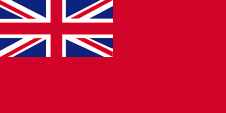 |
Handelsflagge – merchant flag, |
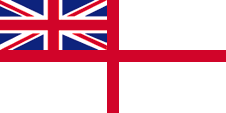 |
Marineflagge – naval flag, |
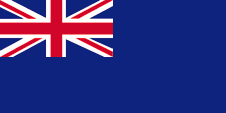 |
Handelsflagge für Reserveoffiziere der Marine – merchant flag for naval reserve officers, |
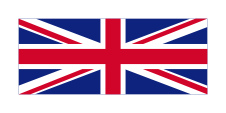 |
Lotsen(ruf)flagge und zivile Gösch – pilot flag and civil jack, Seitenverhältnis – ratio = 1:2, Quelle/Source, nach/by: Flags of all Nations |
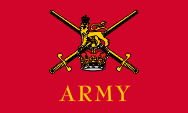 |
Flagge des Heeres – flag of the army, Seitenverhältnis – ratio = 3:5, Quelle/Source, nach/by: Flags of all Nations    |
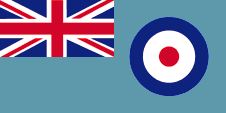 |
Flagge der Königlichen Luftwaffe – flag of the Royal Air Force, Seitenverhältnis – ratio = 1:2, Quelle/Source, nach/by: Flags of all Nations    |
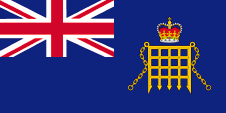 |
Flagge des Zolls – customs ensign, Seitenverhältnis – ratio = 1:2, Quelle/Source, nach/by: Flags of all Nations |
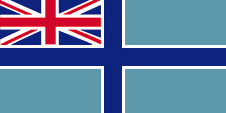 |
Flagge für die Zivilluftfahrt – civil air ensign, Seitenverhältnis – ratio = 1:2, Quelle/Source, nach/by: Flags of all Nations |
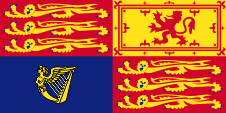 |
Königliche Standarte |
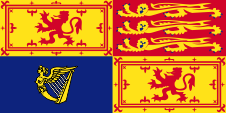 |
Königliche Standarte für den Gebrauch in Schottland – royal standard for use in Scotland, |
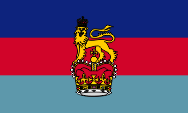 |
Flagge des Verteidigungsministers |
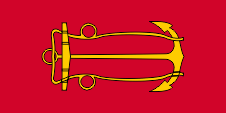 |
Flagge des Lord High Admiral – flag of the Lord High Admiral, Seitenverhältnis – ratio = 1:2, Quelle/Source, nach/by: Flags of all Nations    |
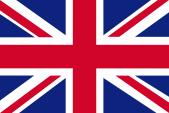 |
Flagge des Admirals der Flotte – flag of the Admiral of the Fleet, Seitenverhältnis – ratio = 2:3, Quelle/Source, nach/by: Flags of all Nations |
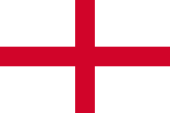 |
Flagge für Admirale – flag for Admirals, Seitenverhältnis – ratio = 2:3, Quelle/Source, nach/by: Flags of all Nations |
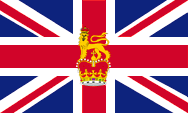 |
Flagge des Chefs des Generalstabs – flag of the Chief of the General Staff, Seitenverhältnis – ratio = 3:5, Quelle/Source, nach/by: Flags of all Nations |
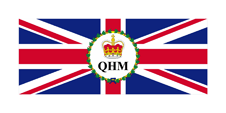 |
Hafenaufsicht der Königin – Queen's Harbour Master, Seitenverhältnis – ratio = 1:2, Quelle/Source, nach/by: Flags of all Nations |
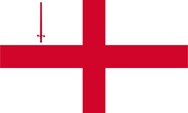 |
Flagge der City of London, des historischen Kerns der Hauptstadt – flag of the City of London, the historical core of the capital, Seitenverhältnis – ratio = 3:5, Quelle/Source, nach/by: Flags of all Nations    |
historische Flaggen – historical Flags: |
|
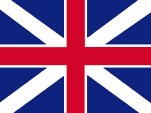 |
1606–1649, Staatsflagge – state flag, 1634–1649, Marineflagge – naval flag, Quelle/Source, nach/by: Die Welt der Flaggen, Wikipedia (EN) |
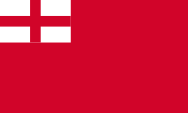 |
1634–1707, Handelsflagge für Schiffe aus England – merchant flag for vessels from England, Quelle/Source, nach/by: Die Welt der Flaggen, Wikipedia (EN) |
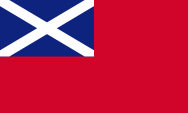 |
1634–1707, Handelsflagge für Schiffe aus Schottland – merchant flag for vessels from Scotland, Quelle/Source, nach/by: Die Welt der Flaggen, Wikipedia (EN) |
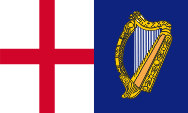 |
1649–1651, Flagge des Commonwealth von England – flag of the Commonwealth of England, Quelle/Source, nach/by: Die Welt der Flaggen, Wikipedia (EN) |
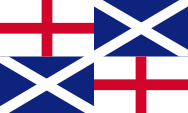 |
1651–1658, Flagge des Commonwealth von England – flag of the Commonwealth of England, Quelle/Source, nach/by: Die Welt der Flaggen, Wikipedia (EN) |
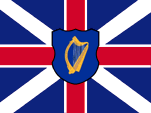 |
1658–1660, Staats- und Marineflagge – state and naval flag, Quelle/Source, nach/by: Die Welt der Flaggen, Wikipedia (EN) |
 |
1660–1801, Staats- und Marineflagge – state and naval flag, Quelle/Source, nach/by: Die Welt der Flaggen, Wikipedia (EN) |
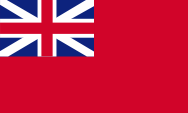 |
1707–1801, Handelsflagge – merchant flag, Quelle/Source, nach/by: Die Welt der Flaggen, Wikipedia (EN) |
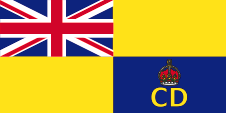 |
1943–1968, Flagge der Zivilverteidigung – flag of the Civil Defense, Seitenverhältnis – ratio = 1:2, Quelle/Source, nach/by: Die Welt im bunten Flaggenbild, Wikipedia (EN) |
| Als Jakob I. (1567–1625), seit 1567 König von Schottland, nach dem Tode der Königin Elisabeth I. im Jahre 1603 die Kronen von Schottland und England in Personalunion vereinigte, wurde für dieses Königtum eine neue Flagge geschaffen, welche die Flaggen Englands und Schottlands vereinigte. Die Flagge Englands ist weiß mit einem durchgehenden roten Balkenkreuz in der Mitte (Kreuz des heiligen Georg → Georgskreuz), und die Flagge Schottlands ist dunkelblau mit einem durchgehenden, weißen Diagonalkreuz in der Mitte (Kreuz des heiligen Andreas → Andreaskreuz). Diese beiden Symbole wurden wirkungsvoll miteinander kombiniert. | When
James I. (1567–1625) – since 1567 King of Scotland and after the death of
Queen Elisabeth I. in 1603 – united the crowns of Scotland and England into
a personal union, a new flag was created for this kingdom, which united the
flags of England and Scotland. The flag of England is white with an uninterrupted red bar cross in the middle (cross of the Holy George → St. George's Cross), and the flag of Scotland is dark blue with an uninterrupted white diagonal cross in the middle (cross of the Holy Andrew → St. Andrew's Cross). Both symbols were effectively combined with each other. |
|
|
|
| Diese Flagge wurde mindestens seit 1633 "Union Jack" genannt. Diese Bezeichnung geht wahrscheinlich direkt auf die Kurzform des Namens des Königs Jakob I. zurück (→ Jack). Mit der Hinrichtung des Königs Karl I. im Jahre 1649 war die dynastische Verbindung mit Schottland zerbrochen worden. Auch machte die Eroberung Irlands im gleichen Jahr eine Änderung der Flagge erforderlich. So wurde nun die Flagge Englands mit dem Wappen von Irland kombiniert. Irland hatte ursprünglich keine Flagge, und wohl auch kein Wappen. Als der englische König Heinrich VIII. im Jahre 1541 auch König von Irland wurde, hatte er aber als irisches Wappen die goldene Harfe auf blauem Grund eingeführt. Mit Wiedereinführung der Monarchie im Jahre 1654 wurde auch der "Union Jack" wiedereingeführt. Die Kombination mit dem irischen Wappen wurde jedoch beibehalten. Im Jahre 1707 erfolgte neben der dynastischen auch die staatsrechtliche Vereinigung Englands mit Schottland zu Großbritannien, und im Jahre 1801 auch die Vereinigung mit Irland. So wurde ab dem 01.01.1801 der "Union Jack" durch das Patrickskreuz, ein rotes durchgehendes Diagonalkreuz ergänzt. Dieses galt als Symbol des Schutzpatrons von Irland (Kreuz des heiligen Patrizius → Patrickskreuz). Damit hatte der "Union Jack" seine heutige Gestalt erhalten. |
This flag
was named the "Union Jack" at least since 1633 . This designation goes
probably back directly to the short form of the name of King James I. (→
Jack). With the execution of King Charles I. in 1649 the dynastic connection
with Scotland was broken. A change in the design of the flag was also
necessary after the capture of Ireland in the same year. In this way the
flag of England was combined with the coat of arms of Ireland. Originally
Ireland had no flag and possibly no coat of arms. When the English King
Henry VIII. also became King of Ireland in 1541 he introduced the golden
harp on a blue ground as the Irish coat of arms. With the re-establishment of the monarchy in the year 1654 the "Union Jack" was also re-established. The combination with the Irish coat of arms was, however, maintained. In 1707 follows, in addition to the dynastic unification, the constitutional unification of England and Scotland into United Kingdom. Then in 1801 follows the unification with Ireland. The Patrick's Cross, a red uninterrupted diagonal cross was added to the "Union Jack" and superimposed onto the Scottish St. Andrew's Cross effective on the 1st of January, 1801. St. Patrick is the patron saint of Ireland (cross of the Holy Patricius → St. Patrick's Cross). With these many changes the "Union Jack" came to its present form. |
|
|
|
| Das irische Patrickskreuz geht auf das Jahr 1783 und König Georg III. zurück, der dieses Symbol für Irland geschaffen hat. Es wird insbesondere in Irland von Teilen der Bevölkerung als englische Kreation abgelehnt. | The Irish Patrick's Cross dates back to to the year 1783 and King George III. who created this symbol for Ireland. In Ireland in particular, parts of the population reject it as an English creation. |
| Wird die schottische Flagge allein, also außerhalb des Union Jack verwendet, muss das Blau zwingend wesentlich heller erscheinen. | If the Scottish flag is used alone, i.e. outside of the Union Jack, the blue must appear much lighter. |
Großbritannien hatte in Jahr 1864 ein Flaggensystem eingeführt, in dem:
Seit 1865 durften Schiffe von Kolonialregierungen einen Blue Ensign mit einem Badge (Abzeichen) im fliegenden Ende führen. Die jeweiligen Regierungen sollten entsprechene Bagdes zur Verfügung stellen. Handelsschiffe und seefahrende Privatpersonen aus Kolonien dürfen nur dann einen Red Ensign mit Badge führen, wenn von der britischen Admiralität eine entsprechende Erlaubnis für die Kolonie erteilt wurde. |
United Kingdom introduced a flag system in 1864 in which:
Since 1865 ships of colonial governments were permitted to fly the Blue Ensign with a badge in the flying end of the flag. The respective governments were asked to design appropriate badges. Merchant ships and seafaring persons from colonies were only permitted to use the Red Ensign with a badge, then also named Civil Ensign, if permission has been given to the respective colony by the British admiralty. |
| Bei britischen Kolonien und abhängigen Gebieten wurde die Darstellung des Badge (bzw. Wappen) sehr häufig im fliegenden Ende des Ensigns auf einer weißen Scheibe platziert. Diese Regelung mit der weißen Scheibe wurde 1999 offiziell abgeschafft, und das Wappen der Kolonie dann vergrößert dargestellt. Allerdings sind noch viele Flaggen im alten Design im Einsatz, vor allem an Land. | In British colonies and dependent territories, the representation of the badge (respectively of the coat of arms) was often placed on a white disc in the flying end of the ensigns. That regulation – with the white disc – was officially abolished in 1999, and the arms of the colony is then represented enlarged. However, there are still many flags in the old design in use, especially on land. |
| Die Farben der Flaggen Großbritanniens sind als Blau pt 280 c und Rot pt 186 c festgelegt. | The colors of the flags of the United Kingdom are specified as blue pt 280c and red pt 186c. |
| Translator of the English text: Joachim Nuthack | |
| Quelle/Source: Die Welt der Flaggen, Wikipedia (EN), Flags of the World, Volker Preuß | |
| Wappen – Coat of arms: | |
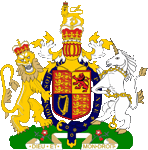 |
Das Wappen von Großbritannien – coat of arms of United Kingdom, Quelle/Source, nach/by: Corel Draw 4 |
| Das
britische Königs- und Staatswappen besteht aus einem viergeteilten Schild,
und zeigt im ersten Feld drei goldene Leoparden auf Rot (England), im
zweiten Feld einen roten Löwen auf Gold (Schottland), im dritten Feld eine
goldene Harfe auf blauem Grund (Irland), und im vierten Feld wieder drei
goldene Leoparden auf Rot (England). Das Wappenschild ist umrundet vom
blauen Hosenbandorden mit der französischen Aufschrift: "Honi soit qui mal y
pense" → "ehrlos sei, wer Arges dabei denkt". Schildhalter sind ein
englischer Löwe und ein schottisches Einhorn. Oberhalb des Schildes ein
goldener Helm mit der Krone des heiligen Eduard, auf welcher der britische
Löwe steht. Das Wappen ruht auf einem Podest, welches eine Wiese mit
Tudor-Rosen darstellt. Am Fuß des Wappens in einem Spruchband in
französischer Sprache das Motto: "Dieu et mon droit" → "Gott und mein
Recht". Seine heutige Gestalt erhielt das britische Königs- und Staatswappen in Jahre 1837 anlässlich der Thronbesteigung von Königin Viktoria. In Schottland ist seit 1910 ein leicht abgewandeltes Wappen und eine leicht abgewandelte Königinflagge in Gebrauch. Die Flagge der Königin ist eine aus dem Wappenschild hervorgegangene Wappenflagge. |
The coat
of arms of the British King and the United Kingdom consists of a quartered
shield and shows in the first (upper left) field three golden leopards on a
red background (England), in the second field a red lion on a golden
background (Scotland), in the third field a golden harp on a blue background
(Ireland), and in the fourth field three golden leopards on a red background
again (England). The blazon is surrounded by the Order of the Garter with
the French inscription: "Honi soit qui mal y pense" → "shame on anyone
who thinks evil of it". The shield holders are an English lion and a Scottish unicorn.
Above the shield sits a golden helmet with the crown of the Holy Edward, on
which the British lion stands. The coat of arms rests on a pedestal which
depicts a meadow with Tudor roses. At the foot of the coat of arms on a
banner the motto reads in French: "Dieu et mon droit" → "God and my right".
The coat of arms of the British King and the United Kingdom received their present format in 1837 on the occasion of the accession to the Throne by Queen Victoria. Since 1910 a slightly changed coat of arms and a slightly changed flag of the queen in use in Scotland. The flag of the queen is developed from the blazon of the scutcheon flag. |
| Translator of the English text: Joachim Nuthack | |
| Quelle/Source: Wikipedia (DE), Flaggen Wappen Hymnen | |
|
Lesen Sie hier: Hintergründe, Geschichte und Fakten zum Thema "Der Löwe in der Heraldik". Ausführungen, Varianten, Entwicklung sowie Panther und Leoparden. |
 |
Flugzeugkokarde – aircraft roundel: |
|
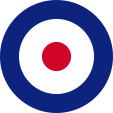 |
Flugzeugkokarde – aircraft roundel Quelle/Source, nach/by Wikipedia (EN) |
| Landkarten – Maps: |
Lage
– Position: |
Landkarte
des Landes – Map of the Country: |
interaktive Landkarte – interactive Map: Quelle/Source: Freeware, University of Texas Libraries, modyfied by: Volker Preuß |
| Zahlen und Fakten – Numbers and Facts: | |
|
|
|
|
|
|
|
|
|
|
|
|
|
|
|
|
|
|
|
|
|
|
ca. 600 v.Chr. · Einwanderung keltischer Stämme auf die Britischen
Inseln 55/54 v.Chr. · erste römische Angriffe 43 · römische Legionen erobern das Gebiet des heutigen England 85 · Britannien wird Provinz des Römischen Reiches 120–128 · Bau des Hadrianswalls gegen die Schotten 195 · der Hadrianswall wird überrannt 200–400 · häufige Aufstände der keltischen Briten gegen die Römer ab ca. 400 · Abzug der römischen Legionen, in den Folgejahren Einwanderung der germanischen Stämme der Angeln, Sachsen und Jüten, die später unter dem Begriff Angelsachsen zusammengefasst wurden 450–500 · Kämpfe der keltischen Briten und Sachsen gegen die Pikten und Scoten, Verdrängung der keltischen Briten durch die Sachsen, Bildung der angelsächsischen Königreiche Sussex, Wessex, Essex, Kent, Ostanglien, Mercien und Nordumbrien 825 · Vereinigung von Wessex, Sussex, Kent und Mercia unter König Egbert von Wessex 865 · Däneninvasion: Essex, Ostanglien und Teile von Mercia werden bis 954 dänischer Besitz → Danelaw 1016 · der Däne Knut der Große erzwingt seine Wahl zum König von England 1050 · Endgültiges Ende der Dänenherrschaft 1066 · der Sachse Harald II. wird König von England 1066 · die einfallenden Normannen besiegen die Angelsachsen in der Schlacht von Hastings und Errichten ihre Herrschaft in England 1169 · beginnende Eroberung von Irland durch das Königreich England 1265 · erstes englisches Parlament 1284 · Eroberung von Wales 1297 · Einrichtung eines ersten irischen Parlaments, die Eroberung von Irland durch das Königreich England ist im Prinzip abgeschlossen 1338–1453 · Hundertjähriger Krieg in Frankreich um Ansprüche des englischen Königs auf den französischen Thron 1455–1485 · Rosenkriege zwischen dem Haus Lancaster (Wappen: rote Rose) und dem Haus York (Wappen: weiße Rose) 1603 · mit Elisabeth I. stirbt das Haus Tudor aus 1603 · Personalunion zwischen Schottland und England unter Jakob I. aus dem Hause Stuart 1649 · Hinrichtung des Königs Karl I. 1649–1654 · England ist Republik unter Oliver Cromwell 1654 · Wiedereinführung der Monarchie 1707 · staatsrechtliche Vereinigung von England und Schottland zu Großbritannien 1714 · die Dynastie Hannover stellt mit Georg I. den König 1727–1760 · umfassende koloniale Eroberungen 1783 · die USA werden von Großbritannien unabhängig 19. Jhd. · Phase weiterer großer kolonialer Eroberungen 1901 · das Haus Sachsen-Coburg-Gotha (Windsor) stellt mit Edward VII. den König 1914–1918 · Erster Weltkrieg 1921 · Bildung des Irischen Freistaates 1939 · Großbritannien erklärt Deutschland den Krieg 1939–1945 · Zweiter Weltkrieg 1947 · Indien wird unabhängig 1956 · Großbritannien interveniert in der Suez-Kanalzone 1960–1966 · Großbritannien verliert fast sein gesamtes Kolonialreich 1969 · Großbritannien interveniert in Nordirland 1973 · das Vereinigte Königreich von Großbritannien und Nordirland tritt der EWG (die spätere EU) bei 1982 · Argentinien besetzt die Falklandinseln, britische Rückeroberung 1991 · Großbritannien interveniert mit den USA im Irak 1999 · Beteiligung Großbritanniens an der NATO-Intervention in Jugoslawien 1999 · Schottland und Wales erhalten eigene Landesparlamente, Nordirland erhält Autonomie 2000 · die Autonomie für Nordirland wird wieder rückgängig gemacht 2003 · Großbritannien interveniert mit den USA erneut und widerrechtlich im Irak 2016 · eine Volksabstimmung in Großbritannien entscheidet mehrheitlich für ein Verlassen der Europäischen Union 31.01.2020 · Großbritannien verlässt die Europäische Union |
|
ca. 600 B.C. · immigration of Celtic tribes to the British Isles 55/54 B.C. · first Roman attacks 43 · Roman legions conquer the region of the today's England 85 · Britain becomes a province of the Roman Empire 120–128 · construction of Hadrian's Wall against the Scots 195 · Hadrian's Wall is overrun 200–400 · frequent riotings of the British Celts against the Roman from ca. 400 · withdrawal of the Roman legions, in the following years immigration of the Germanic tribes of the Angles, Saxons and Jutes, which were later summarized under the term Anglo-Saxons 450–500 · battles of the British Celts and Saxon against the Pikts and Scots, ousting of the British Celts by the Saxons, formation of the Anglo-Saxon kingdoms of Sussex, Wessex, Essex, Kent, East Anglia, Mercia and Northumbria 825 · unification of Wessex, Sussex, Kent and Mercia under King Egbert of Wessex 865 · Danish invasion: Essex, East Anglia and parts of Mercia become Danish possession until 954 → Danelaw 1016 · the Dane Knut the Great forces his election as King of England 1050 · ultimate end of the Danish rule 1066 · the Saxon Harald II. becomes king of England 1066 · the invading Normans defeat the Saxons in the Battle of Hastings and establish their power in England 1169 · beginning of the conquest of Ireland by the Kingdom of England 1265 · first English parliament 1284 · conquest of Wales 1297 · establishment of a first Irish Parliament, the conquest of Ireland by the Kingdom of England is essentially complete 1338–1453 · 100-year War in France for rights of the English King to the French throne 1455–1485 · War of the Roses between the House of Lancaster (coat of arms: red rose) and the House of York (coat of arms: white rose) 1603 · the House of Tudor line ends with the death of Elisabeth I. 1603 · personal union between Scotland and England under James I. of the House of Stuart 1649 · execution of King Charles I. 1649–1654 · England is a republic under Oliver Cromwell 1654 · re-establishment of the monarchy 1707 · constitutional unification of England and Scotland to Great Britain 1714 · the House of Hanover provides a king with George I. 1727–1760 · extensive colonial conquests 1783 · the USA achieve independence from United Kingdom 19th cent. · phase of further large colonial conquests 1901 · the House Saxony-Coburg-Gotha (Windsor) provides the king with Edward VII. 1914–1918 · First World War 1921 · creation of the Irish free state 1939 · United Kingdom declares war on Germany 1939–1945 · Second World War 1947 · India receives independence 1956 · United Kingdom intervenes in the Suez-Canal-Zone 1960–1966 · United Kingdom loses most of its colonial empire 1969 · United Kingdom intervenes in Northern Ireland 1973 · the United Kingdom of Great Britain and Northern Ireland joines the EEC (the later EU) 1982 · Argentina occupies the Falkland Islands, British re-capture 1991 · United Kingdom intervenes with the USA in Iraq 1999 · participation of United Kingdom in the NATO-intervention in Yugoslavia 1999 · Scotland and Wales get their own parliaments, Northern Ireland receives autonomy 2000 · the autonomy for Northern Ireland is reversed 2003 · United Kingdom intervenes with the USA in Iraq again and illegally 2016 · a referendum in Britain decides with a majority to leave the European Union 31st of Janauary in 2020 · United Kingdom (UK) leaves the European Union |
| Translator of the English text: Joachim Nuthack |
| Quelle/Source: Atlas zur Geschichte, World Statesmen, Wikipedia (D) |
| Außenbesitzungen – Possessions: (mit eigener Flagge – with own flag)
• Anguilla |
Regionalflaggen – regional Flags:
• Alderney (Kanalinseln – Channel Islands) |
| Im gesamten englischen Sprachraum ist das Land nur als "United Kingdom" bekannt, was das Königreich als die Vereinigung von England, Schottland und Nordirland meint. Im deutschen Sprachraum wird die Übersetzung des Landesnamens als "Vereinigtes Königreich" so gut wie gar nicht verwendet. Hier sagt man "Großbritannien". Mit "Großbritannien" wird aber eigentlich nur die Vereinigung von England und Schottland bezeichnet. | In the entire English-speaking world, the country is known only as "United Kingdom", which means the kingdom as the union of England, Scotland and Northern Ireland. In the German-speaking world, the translation of the country's name as "Vereinigtes Königreich" (United Kingdom) is hardly used at all. Here they say "Großbritannien → Great Britain". "Great Britain" actually only refers to the union of England and Scotland. |
| Als im Jahr 1707 der Staat
Großbritannien durch die Vereinigung von England und Schottland geschaffen
und eben "Großbritannien" genannt worden war, war – auch in den
Jahrhunderten davor – immer ein "Britannien" präsent. Erstens hieß das Land als römische Privinz "Britannia", und zweitens gab es die Bretagne
(Britannia), die Heimat der Bretonen, die keltischen Brüder der
Urbevölkerung der Britischen Inseln. Das entstehende neue Britannien, war natürlich größer und bedeutender. So lag es nahe, erstens einen Begriff zu wählen, der weder England noch Schottland benachteiligt, und zweitens eine Unterscheidung zur Bretagne hergibt. |
In 1707,
when United Kingdom was created, by the union of England and Scotland and
when it was named "Great Britain", then, and even in the centuries before, a
"Britannia" was always present. Firstly the country was called "Britannia" as a Roman province, and secondly ther was the Brittany, the home of the Bretons, the Celtic brothers of the indigenous people of the British Isles.
The now emerging new Britain, was of course bigger and more significant. It was therefore a good idea to choose on the one hand a name, which disadvantaged neither England nor Scotland, and on the other hand gives a possibility for distinction from Brittany. |
| Quelle/Source: Volker Preuß | |